In Situ Experimental Study of the Friction of Sea Ice and Steel on Sea Ice
Abstract
:1. Introduction
2. Materials and Methods
2.1. Sliding Tracks
2.2. Sliders
2.3. Experimental Set-Up
2.4. Test Parameters
2.4.1. Parameter Selection Criteria
2.4.2. Test Parameters
3. Results
3.1. Friction Regimes
3.2. Effect of Normal Stress
3.3. Effect of Sea Ice Columnar Grain Orientation
3.4. Effect of Contact Materials
3.5. Effect of Sliding Velocity
4. Discussion
4.1. Uncertainty Analysis
4.1.1. Repeated Sliding
4.1.2. System Stiffness
4.2. Surface Roughness
4.3. Stick-Slip
4.4. Effect of Air Temperature
4.5. Velocity Dependence
4.6. Approximate Comparisons between Model Estimation and Experimental Data
5. Conclusions
Author Contributions
Acknowledgments
Conflicts of Interest
References
- Comiso, J.C.; Parkinson, C.L.; Gersten, R.; Stock, L. Accelerated decline in the Arctic sea ice cover. J. Geophys. Res. 2008, 35, 1–6. [Google Scholar] [CrossRef]
- Stroeve, J.C.; Kattsov, V.; Barrett, A.; Serreze, M.; Pavlova, T.; Holland, M.; Meier, W.N. Trends in Arctic sea ice extent from CMIP5, CMIP3 and observations. Geophys. Res. Lett. 2012, 39, L16502. [Google Scholar] [CrossRef]
- Renner, A.H.H.; Gerland, S.; Haas, C.; Spreen, G.; Beckers, J.F.; Hansen, E.; Nicolaus, M.; Goodwin, H. Evidence of Arctic sea ice thinning from direct observations. Geophys. Res. Lett. 2014, 41, 5029–5036. [Google Scholar] [CrossRef] [Green Version]
- Lindsay, R.; Schweiger, A. Arctic sea ice thickness loss determined using subsurface, aircraft, and satellite observations. Cryosphere 2015, 9, 269–283. [Google Scholar] [CrossRef]
- Khon, V.C.; Mokhov, I.I. Arctic climate changes and possible conditions of Arctic navigation in the 21st century. Izv. Atmos. Ocean. Phys. 2010, 46, 14–20. [Google Scholar] [CrossRef]
- Liu, M.; Kronbak, J. The potential economic viability of using the Northern Sea Route (NSR) as an alternative route between Asia and Europe. J. Transp. Geogr. 2010, 18, 434–444. [Google Scholar] [CrossRef]
- Rothwell, D.R. International straits and trans-Arctic navigation. Ocean Dev. Int. Law 2012, 43, 267–282. [Google Scholar] [CrossRef]
- Shibata, H.; Izumiyama, K.; Tateyama, K.; Enomoto, H.; Takahashi, S. Sea-ice coverage variability on the Northern Sea Routes, 1980–2011. Ann. Glaciol. 2013, 54, 139–148. [Google Scholar] [CrossRef]
- Wang, Q.; Li, Z.; Lu, P.; Lei, R.; Cheng, B. 2014 summer Arctic sea ice thickness and concentration from shipborne observations. Int. J. Digit. Earth 2018, 1–17. [Google Scholar] [CrossRef]
- Zhang, M.; Zhang, D.; Fu, S.; Yan, X.; Goncharov, V. Safety distance modeling for ship escort operations in Arctic ice-covered waters. Ocean Eng. 2017, 146, 202–216. [Google Scholar] [CrossRef]
- Liukkonen, S. Friction panel measurements in full-scale and model-scale icebreaking ship tests. J. Offshore Mech. Arct. Eng. 1989, 111, 251–253. [Google Scholar] [CrossRef]
- Valanto, P. The resistance of ships in level ice. Soc. Nav. Archit. Marine Eng. 2001, 109, 53–83. [Google Scholar]
- Petrenko, V.F. The effect of static electric fields on ice friction. J. Appl. Phys. 1994, 76, 1216–1219. [Google Scholar] [CrossRef]
- Timco, G.W.; Frederking, R.M.W. Compressive strength of sea ice sheets. Cold Reg. Sci. Technol. 1990, 17, 227–240. [Google Scholar] [CrossRef]
- Kovacs, A. Estimating the full-scale flexural and compressive strength of first-year sea ice. J. Geophys. Res. 1997, 102, 8681–8689. [Google Scholar] [CrossRef]
- Han, H.; Li, Z.; Huang, W.; Lu, P.; Lei, R. The uniaxial compressive strength of Arctic summer sea ice. Acta Oceanol. Sin. 2015, 34, 129–136. [Google Scholar] [CrossRef]
- Moslet, P.O. Field testing of uniaxial compression strength of columnar sea ice. Cold Reg. Sci. Technol. 2007, 48, 1–14. [Google Scholar] [CrossRef]
- Lu, W.; Lubbad, R.; Løset, S.; Kashafutdinovet, M. Fracture of an ice floe: Local out-of-plane flexural failures versus global in-plane splitting failure. Cold Reg. Sci. Technol. 2016, 123, 1–13. [Google Scholar] [CrossRef]
- Lian, J.; Ouyang, Q.; Zhao, X.; Liu, F.; Qi, C. Uniaxial compressive strength and fracture mode of lake ice at moderate strain rates based on a digital speckle correlation method for deformation measurement. Appl. Sci. 2017, 7, 495. [Google Scholar] [CrossRef]
- Wang, Q.; Li, Z.; Lei, R.; Lu, P.; Han, H. Estimation of the uniaxial compressive strength of Arctic sea ice during melt season. Cold Reg. Sci. Technol. 2018, 151, 9–18. [Google Scholar] [CrossRef]
- Oksanen, P.; Keinonen, J. The mechanism of friction of ice. Wear 1982, 78, 315–324. [Google Scholar] [CrossRef]
- Yasutome, A.; Arakawa, M.; Maeno, N. Measurements of ice-ice friction coefficients. J. Jpn. Soc. Snow Ice 1999, 61, 437–443. [Google Scholar] [CrossRef]
- Kennedy, F.E.; Schulson, E.M.; Jones, D.E. The friction of ice on ice at low sliding velocities. Philos. Mag. A 2000, 80, 1093–1110. [Google Scholar] [CrossRef]
- Maeno, N.; Arakawa, M.; Yasutome, A.; Mizukami, N.; Kanazawa, S. Ice-ice friction measurements and water lubrication and adhesion-shear mechanisms. Can. J. Phys. 2003, 81, 241–249. [Google Scholar] [CrossRef]
- Schulson, E.M.; Fortt, A.L. Friction of ice on ice. J. Geophys. Res. B Solid Earth 2012, 117, 1–18. [Google Scholar] [CrossRef]
- Frederking, R.; Barker, A. Friction of sea ice on steel for condition of varying speeds. In Proceedings of the 12th International Offshore and Polar Engineering Conference, Kitakyushu, Japan, 26–31 May 2002. [Google Scholar]
- Wallen-Russell, C.; Lishman, B. The friction of saline ice on aluminium. Adv. Tribol. 2016, 2016, 1–7. [Google Scholar] [CrossRef] [Green Version]
- Tusima, K.; Tabata, T. Friction measurements of sea ice on flat plates of metals, plastics and coatings. In Proceedings of the 5th International Conference on Port and Ocean Engineering under Arctic Conditions, Trondheim, Norway, 23–30 August 1979. [Google Scholar]
- Saeki, H.; Ono, T.; Nakazawa, N.; Sakai, M.; Tanaka, S. The coefficient of friction between sea ice and various materials used in offshore structures. J. Energy Resour. Technol. 1986, 108, 65–71. [Google Scholar] [CrossRef]
- Evans, D.C.B.; Nye, J.F.; Cheeseman, K.J. The kinetic friction of ice. Proc. R. Soc. A Math. Phys. Eng. Sci. 1976, 347, 493–512. [Google Scholar] [CrossRef]
- Blackford, J.R.; Skouvaklis, G.; Purser, M.; Koutsos, V. Friction on ice: stick and slip. Faraday Discuss. 2012, 156, 243–254. [Google Scholar] [CrossRef] [PubMed]
- Akkok, M.; Ettles, C.M.M.; Calabrese, S.J. Parameters affecting the kinetic friction of ice. J. Tribol. 1987, 109, 552–559. [Google Scholar] [CrossRef]
- Higgins, D.D.; Marmo, B.A.; Jeffree, C.E.; Koutsos, V.; Blackford, J.R. Morphology of ice wear from rubber-ice friction tests and its dependence on temperature and sliding velocity. Wear 2008, 265, 634–644. [Google Scholar] [CrossRef]
- Löptien, U.; Axell, L. Ice and AIS: Ship speed data and sea ice forecasts in the Baltic Sea. Cryosphere 2014, 8, 2409–2418. [Google Scholar] [CrossRef] [Green Version]
- Lishman, B.; Sammonds, P.; Feltham, D. A rate and state friction law for saline ice. J. Geophys. Res. Ocean. 2011, 116, 1–13. [Google Scholar] [CrossRef]
- Pritchard, R.S.; Knoke, G.S.; Echert, D.C.S. Sliding friction of sea ice blocks. Cold Reg. Sci. Technol. 2012, 76–77, 8–16. [Google Scholar] [CrossRef]
- Sukhorukov, S.; Løset, S. Friction of sea ice on sea ice. Cold Reg. Sci. Technol. 2013, 94, 1–12. [Google Scholar] [CrossRef]
- Huang, W.; Lei, R.; Han, H.; Li, Z. Physical structures and interior melt of the central Arctic sea ice/snow in summer 2012. Cold Reg. Sci. Technol. 2016, 124, 127–137. [Google Scholar] [CrossRef]
- Li, Z.; Kang, J.; Pu, Y. Characteristics of the Bohai Sea and Arctic sea ice fabrics and crystals. Acta Oceanol. Sin. 2003, 25, 48–53. (In Chinese) [Google Scholar]
- Weeks, W.F.; Ackley, S.F. The growth, structure and properties of sea ice. In The Geophysics of Sea Ice; Unterstiener, N., Ed.; Plenum: New York, NY, USA, 1986; Volume 146, pp. 9–164. [Google Scholar]
- Lemke, P. The Expedition of the Research Vessel “Polarstern” to the Antarctic in 2006 (ANT-XXIII/7); Alfred Wegener Institute for Polar and Marine Research: Bremerhaven, Germany, 2009; pp. 1866–3192. [Google Scholar]
- Mizukami, N.; Maeno, N. Normal stress dependence of ice-ice friction coefficients. J. Jpn. Soc. Snow Ice 2000, 62, 515–521. [Google Scholar] [CrossRef]
- Makkonen, L.; Tikanmäki, M. Modeling the friction of ice. Cold Reg. Sci. Technol. 2014, 102, 84–93. [Google Scholar] [CrossRef]
- Dieterich, J.H. Time-dependent friction and the mechanics of stick-slip. Pure Appl. Geophys. 1978, 116, 790–806. [Google Scholar] [CrossRef]
- Makkonen, L. Ice adhesion—Theory, measurements and countermeasures. J. Adhes. Sci. Technol. 2012, 26, 413–445. [Google Scholar] [CrossRef]
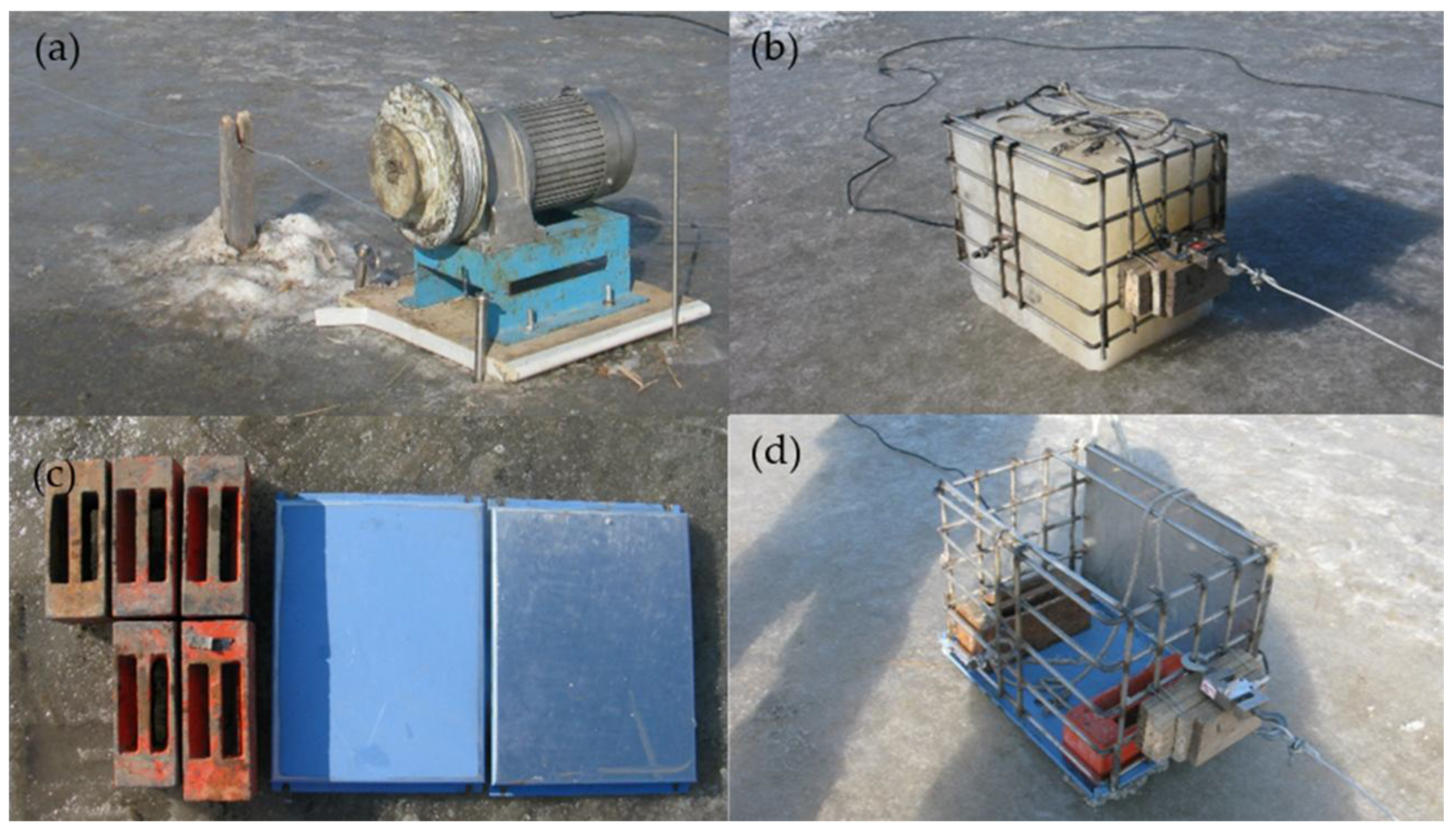
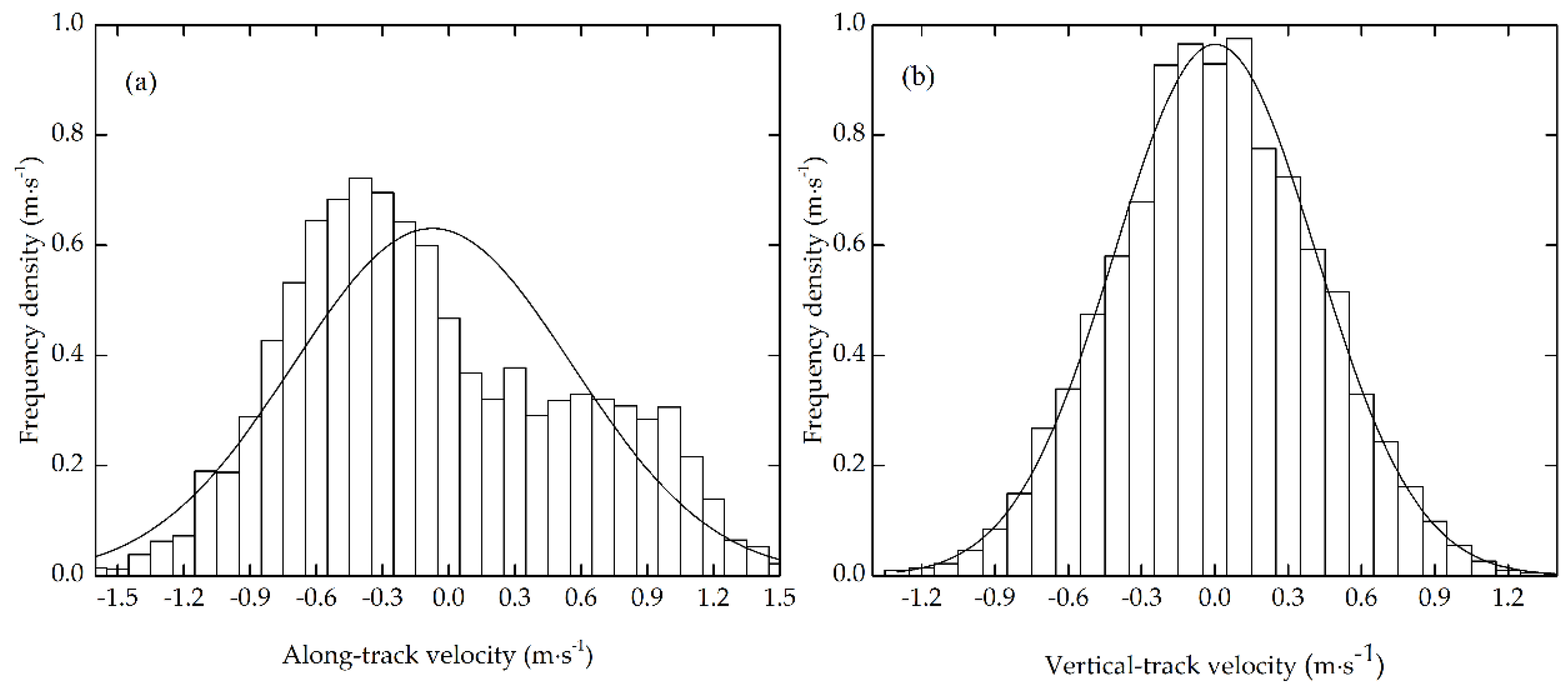

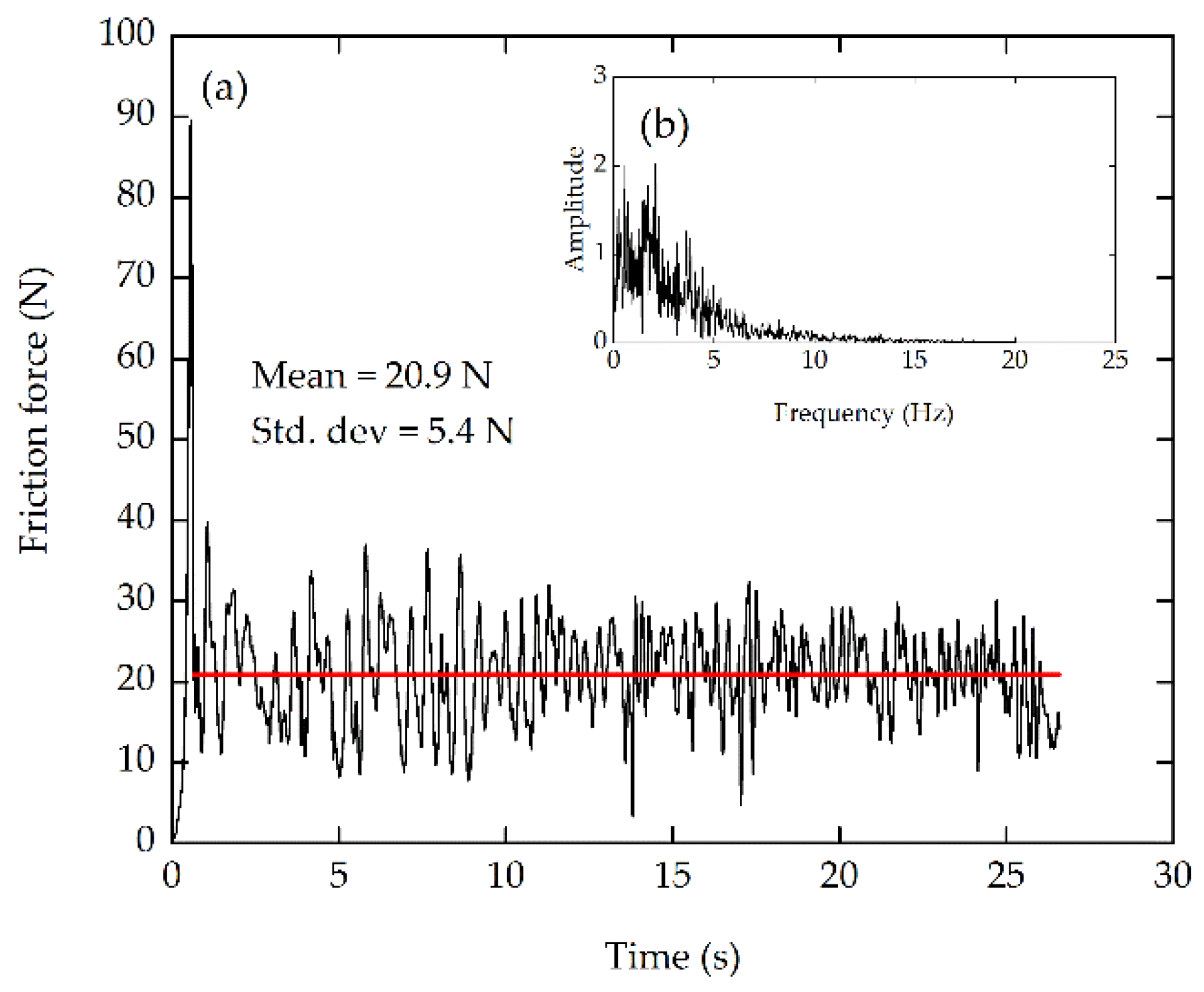

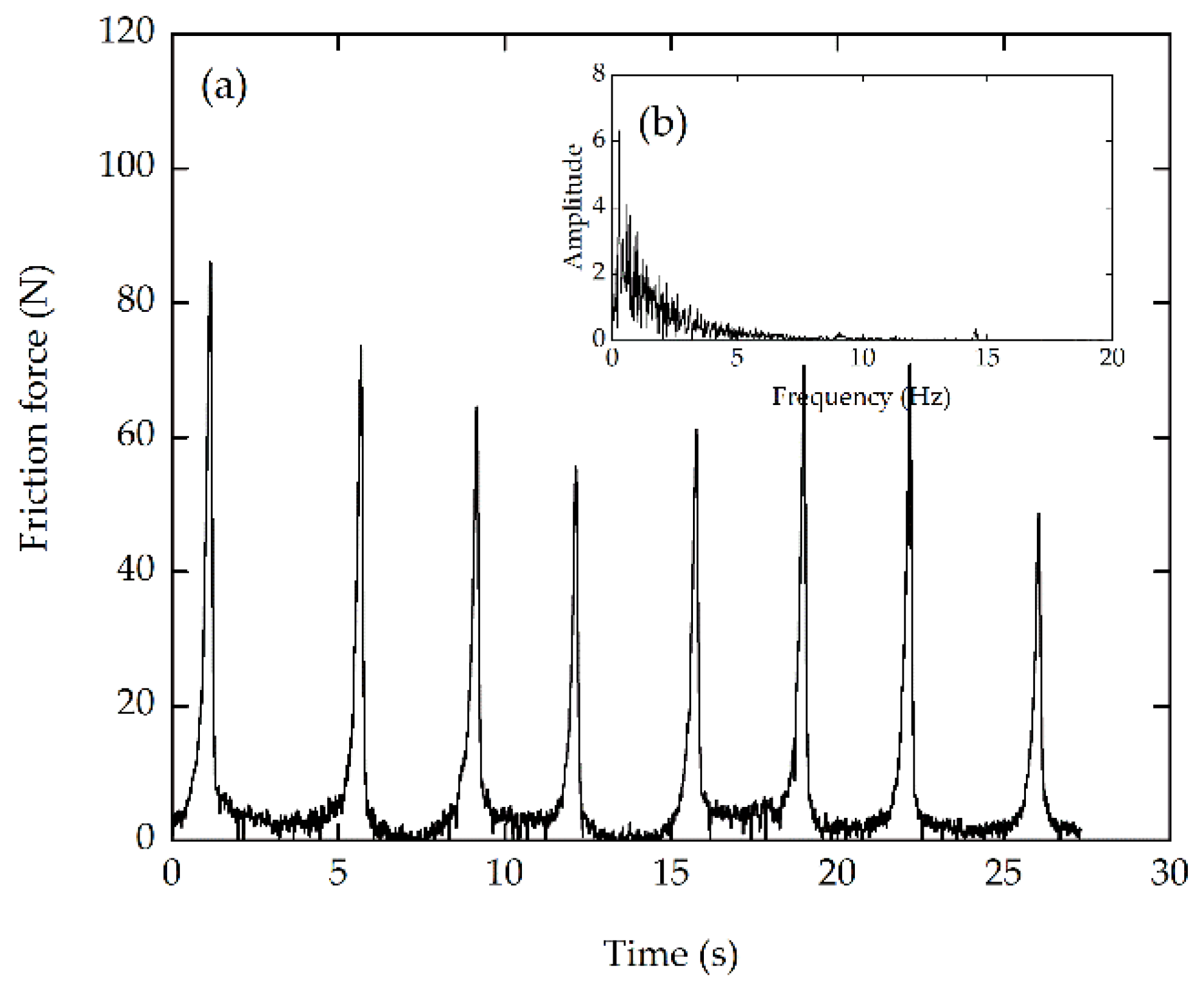

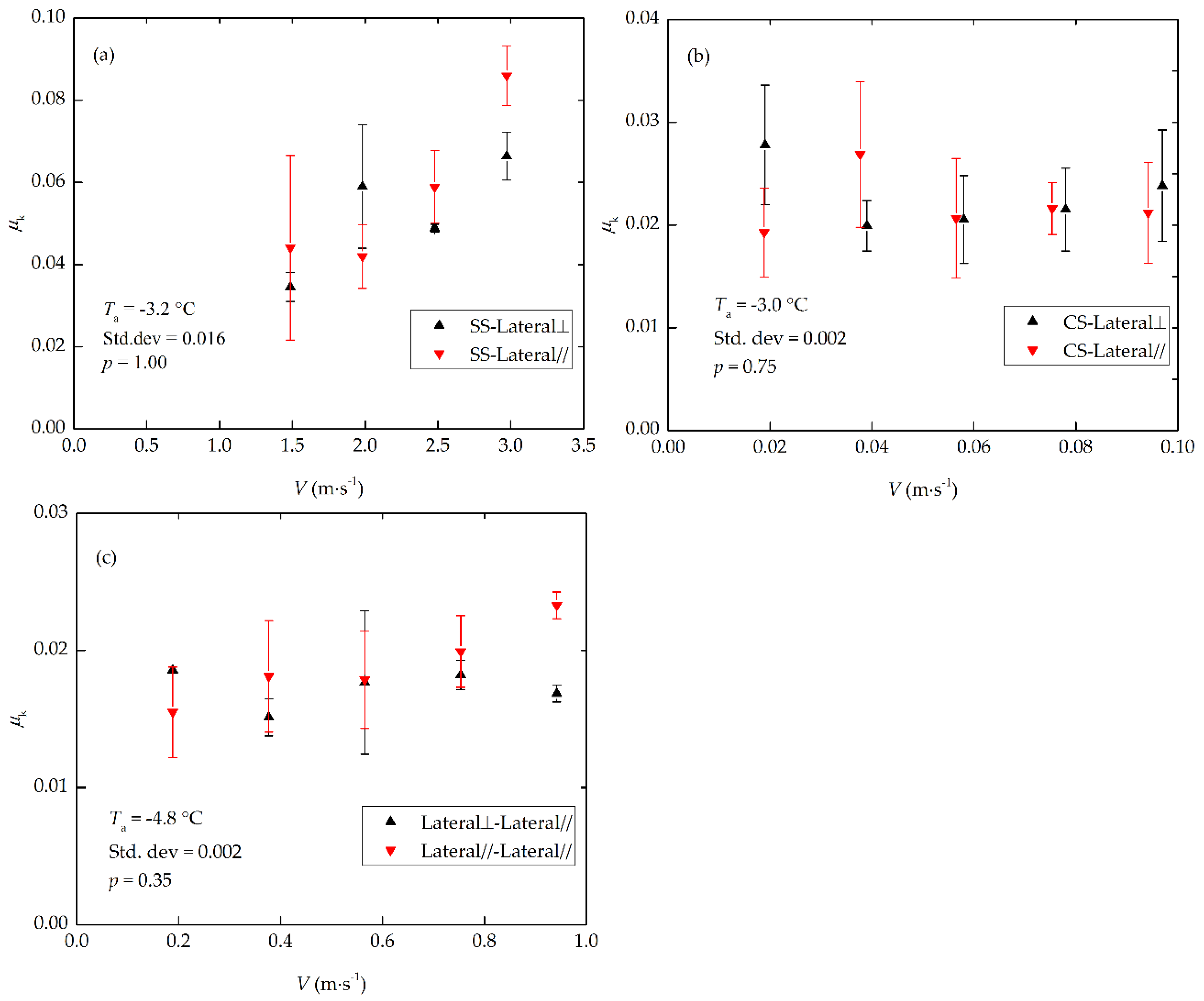

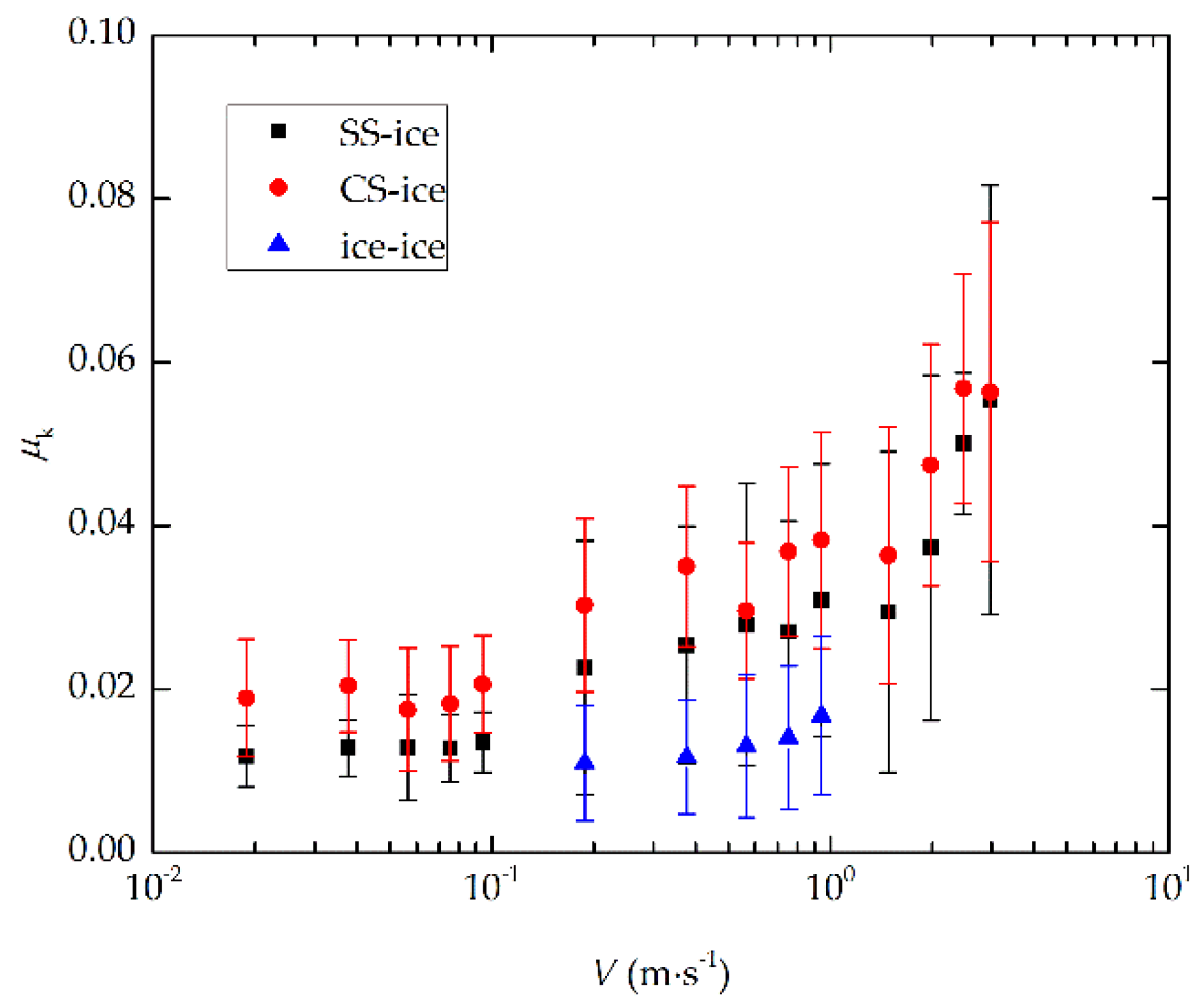
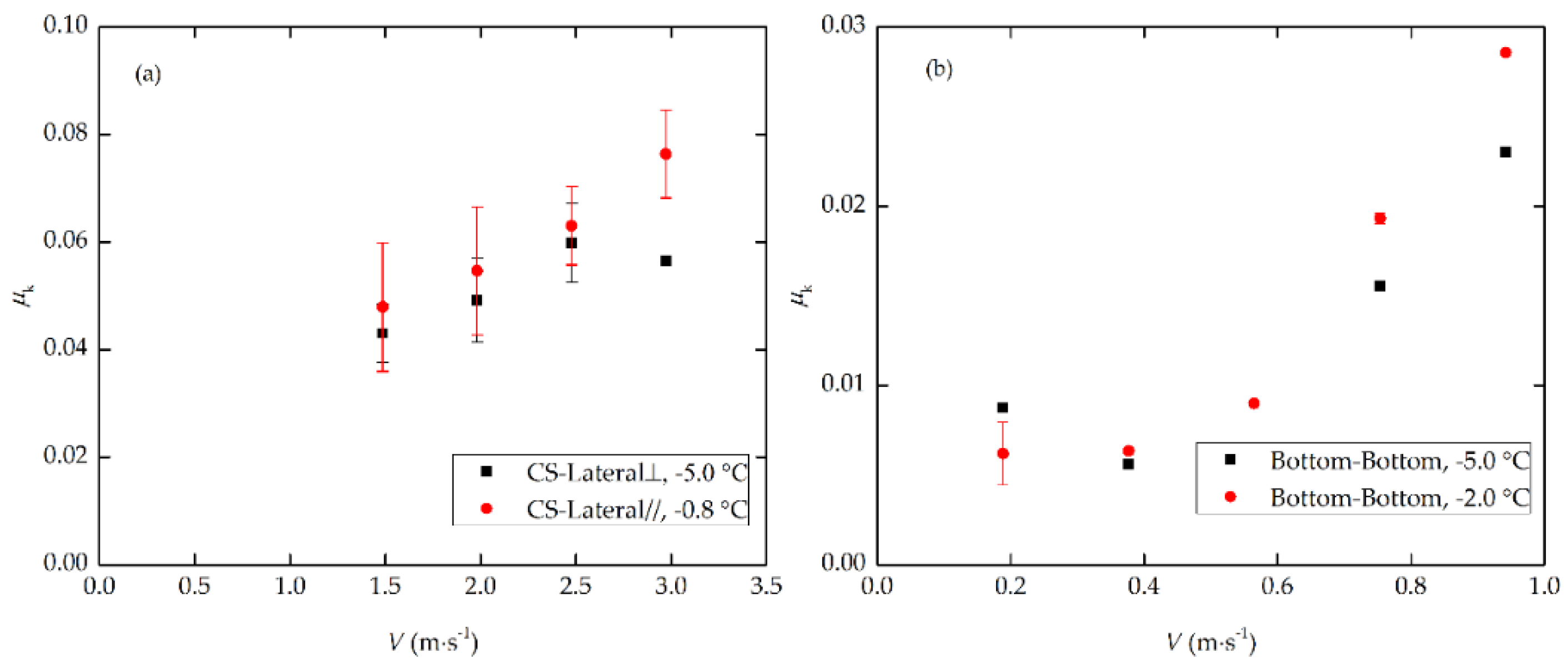


| Reference | Loading System | Test Temperature (°C) | P (kPa) | V (m·s−1) |
|---|---|---|---|---|
| [23] | Uniaxial testing system | −3 | 7–1000 | 10−5–5 × 10−2 |
| −40–−10 | 5 × 10−5–5 × 10−2 | |||
| [24] | Rotation device and uniaxial testing system | −30–0 | 1.2–370 | 10−5–10−3 |
| [35] | Pusher in a basin | −10 | 10 | 3 × 10−3 |
| [37] | Linear actuator in field | −20–−2 | 4–36 | 6 × 10−3–3 × 10−2 |
| Friction | μ0 | C | R2 |
|---|---|---|---|
| SS-ice | 6.6 × 10−5 | 7.5 × 10−3 | 0.83 |
| CS-ice | 7.0 × 10−3 | 7.4 × 10−3 | 0.85 |
| ice-ice | 6.2 × 10−4 | 3.3 × 10−3 | 0.79 |
© 2018 by the authors. Licensee MDPI, Basel, Switzerland. This article is an open access article distributed under the terms and conditions of the Creative Commons Attribution (CC BY) license (http://creativecommons.org/licenses/by/4.0/).
Share and Cite
Wang, Q.; Li, Z.; Lu, P.; Cao, X.; Leppäranta, M. In Situ Experimental Study of the Friction of Sea Ice and Steel on Sea Ice. Appl. Sci. 2018, 8, 675. https://doi.org/10.3390/app8050675
Wang Q, Li Z, Lu P, Cao X, Leppäranta M. In Situ Experimental Study of the Friction of Sea Ice and Steel on Sea Ice. Applied Sciences. 2018; 8(5):675. https://doi.org/10.3390/app8050675
Chicago/Turabian StyleWang, Qingkai, Zhijun Li, Peng Lu, Xiaowei Cao, and Matti Leppäranta. 2018. "In Situ Experimental Study of the Friction of Sea Ice and Steel on Sea Ice" Applied Sciences 8, no. 5: 675. https://doi.org/10.3390/app8050675




